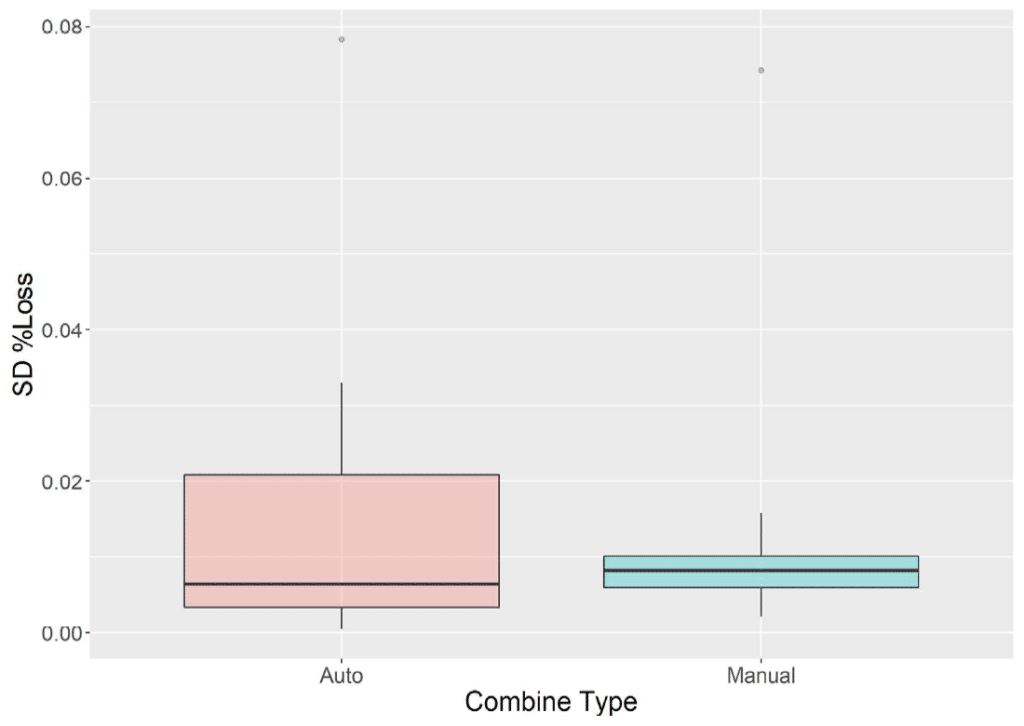Key Result
Both manual adjustments and auto-adjusting features can reduce harvest losses in canola. Auto-adjusting can respond to changing environmental conditions, but should still be calibrated and ground-truthed regularly to reduce losses and optimize yield.
Project Summary
Canola is an essential crop in the Canadian Prairies, and canola losses are an unfortunate part of harvest that must be managed by producers. Canola harvest losses can be environmental losses (prior to cutting or gathering), header losses (during swathing, swath pickup or straight cutting), or combine losses. Combine losses occur during harvesting and refer to grain lost (discarded with the chaff and straw) from the separation and cleaning systems.
In 2019, the Prairie Agricultural Machinery Institute (PAMI) conducted a survey of canola losses in Western Canada to identify the harvest factors that impact canola harvest losses. This On-Farm Survey of Combine Grain Loss in Canola Across Western Canada study found that weather conditions are a key factor influencing combine losses, and that combines should be set based on these conditions. It also noted the importance for producers to reassess their combine losses as conditions change both throughout the day and harvest season.
Auto-adjusting separation and cleaning systems being introduced by the major combine manufacturers may provide a daily opportunity for producers to retain more seed by automatically adjusting settings to reduce losses throughout a harvest day as environmental conditions change.

The objective of this project was to build on the study completed in 2019 and further investigate the effect of changing environmental conditions during a harvest day and the methods used to adjust “on-the-fly” to minimize losses. A total of 22 combines were tested (11 with auto-adjusting capabilities and 11 without).
The data collected and analyzed reported that mean daily temperature had a significant effect (P<0.05) on harvest yield loss while variation of temperature and humidity throughout the day (represented by standard deviation) did not appear to have a significant effect on the variability of percentage yield loss throughout the day.
Key results from this experiment included:
- The average combine losses ranged from 0.1 to 10.6 bu./ac., or 0.2 to 29.4 per cent of total yield.
- As average daily temperatures increased, the variation in yield losses increased significantly. However, the variation in temperature and humidity throughout the day (from three different sample times), did not effect yield loss variation.
- There was no significant difference between swathed and straight cut operations or different ground speeds tested.
- Calendar date (ranging from September 9 to October 10) did not have a significant impact on losses.
- Interestingly, while there was no significant difference between losses in auto-adjusting and manual-adjusting capabilities, there was much less variation in the losses for the manual adjusting combine types than the auto-adjusting types.
This indicates that checking for losses is important and auto-adjusting combines still need calibration and monitoring to ensure that they are properly responding to changing conditions.

There is not a standard set of combine settings that can be attributed to specific losses. Each combine, operating in particular conditions for a specific crop, must be optimized for the given environment. Auto-adjusting capabilities in new combines have the potential to effectively respond to changing environmental conditions, but they cannot just be set and forgotten. They should be calibrated regularly, and it is important to regularly measure losses to ensure adjustments are made to properly optimize harvest yield by reducing combine losses. While it may allow more frequent adjustment to changing conditions without the inefficiencies of conducting loss measurements manually, auto-adjust feature does not negate the requirement to measure.
Overall, combine operators need to know what is happening to make informed management decisions and any method of checking for losses is better than not checking at all.
Acknowledgements
In addition to the funders and PAMI, this project acknowledges Bushel Plus and Schergain for providing support, and the many canola producers throughout Saskatchewan and Manitoba who volunteered to participate in this project.
Related research and resources
- For more harvest loss research, check out the On-Farm Survey of Combine Grain Loss in Canola Across Western Canada study.
- Read the earlier Canola direct-cut harvest system development study, investigating header losses and Investigation into converting a combine grain-loss signal into a grain-loss rate which investigates the feasibility of converting a combine’s loss sensor signal into a grain loss rate.
- For more on how to measure harvest losses, see the Canola Calculator’s Harvest Loss tool. To learn how to reduce your harvest losses, check out the Combine Optimization Tool.





